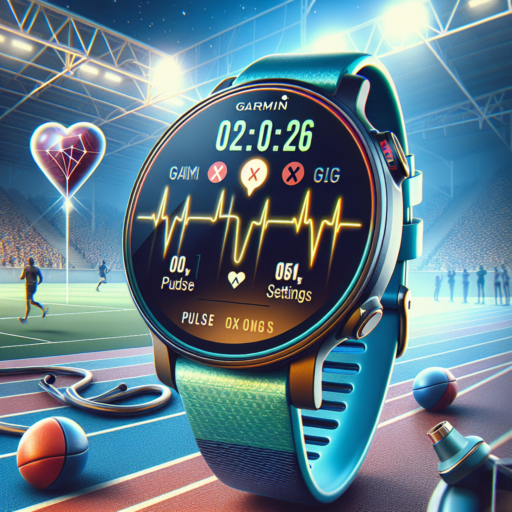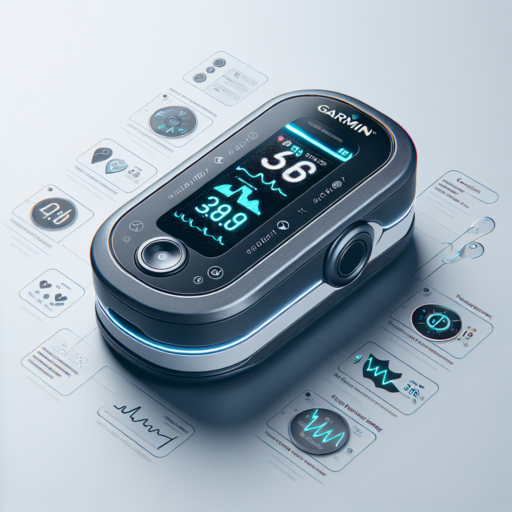Understanding Garmin’s Pulse Ox Feature
The Garmin Pulse Ox feature is a groundbreaking technology designed to monitor oxygen saturation levels in the bloodstream, providing users with valuable insights into their overall health and fitness. By utilizing a method known as pulse oximetry, this feature shines a light through the skin to estimate the amount of oxygen in your blood. Understanding how to leverage this information can significantly enhance one’s training and awareness of their body’s needs.
How Pulse Oximetry Works
Pulse oximetry, the science behind Garmin’s Pulse Ox feature, uses light beams to estimate the oxygen saturation of your blood. This non-invasive method involves a sensor that emits light wavelengths through the skin to the blood vessels below. By analyzing the light that is absorbed by oxygenated and deoxygenated blood, the device provides a percentage of your blood oxygen level. Regular monitoring, especially in high-altitude environments or during intense training sessions, can offer crucial data for optimizing performance and recovery.
The Benefits of Monitoring Blood Oxygen Levels
Keeping an eye on your blood oxygen levels with Garmin’s Pulse Ox can serve as a vital health metric. For athletes and fitness enthusiasts, it plays a crucial role in assessing how well the body is adapting to exercise and stress. Increased oxygen levels could indicate an enhanced ability to deliver oxygen throughout the body, crucial for endurance activities. Conversely, lower oxygen levels might signal the need for rest or a slower pace in training, preventing overexertion and potential injury.
Understanding Garmin’s Pulse Ox feature not only enriches your fitness regime but also empowers you with knowledge about your body’s physiological responses to different environments and activities. This insight, when used correctly, can be a powerful tool in achieving optimal health and performance outcomes.
How Pulse Ox on Garmin Devices Works
Understanding the technology behind the Pulse Ox feature on Garmin devices can be fascinating for fitness enthusiasts and health-conscious individuals. Garmin’s innovative approach to monitoring blood oxygen saturation levels, or SpO2, offers insights into your physical condition, especially during activities at high altitudes or while sleeping. This advanced feature relies on a combination of hardware and software to provide accurate and vital health metrics.
The Pulse Ox sensor on Garmin devices operates by emitting beams of light through the skin to the blood vessels below. By analyzing the absorption of the light by the blood, the device calculates the percentage of oxygen in the blood. This process, known as photoplethysmography, is non-invasive and provides real-time data on your oxygen saturation levels. Garmin devices use red and infrared light sensors to distinguish between oxygenated and deoxygenated blood, which is essential for determining your body’s SpO2 levels accurately.
To enhance the accuracy of the readings, it’s recommended to wear the Garmin device firmly around your wrist. Proper placement ensures that the sensors maintain consistent contact with the skin, reducing the likelihood of discrepancies in the data collected. Additionally, Garmin devices equipped with the Pulse Ox feature often come with software that analyzes the data over time, enabling users to track trends and make informed decisions about their health and fitness routines.
The Health Benefits of Monitoring Your Oxygen Saturation with Garmin
Monitoring your oxygen saturation, or SpO2 levels, has become an essential part of maintaining overall health and Garmin devices provide an easy and efficient way to do so. Understanding the significance of these levels and keeping a close eye on them with your Garmin device can lead to a multitude of health benefits.
Preventative Health Management
One of the key benefits of monitoring your oxygen saturation with Garmin is preventative health management. Keeping track of your SpO2 can help you notice changes in your body that may indicate underlying health issues, such as sleep apnea or heart conditions, before they become more serious. It allows individuals to take proactive steps towards their health, potentially preventing conditions from worsening.
Improving Exercise and Training Efficiency
For athletes and fitness enthusiasts, Garmin’s oxygen saturation monitoring feature can be a game-changer. Understanding your SpO2 levels during different phases of exercise can help tailor your training programs to improve exercise efficiency and recovery. By ensuring your body is receiving enough oxygen during workouts, you can optimize your performance and reduce the risk of fatigue and injury.
Additionally, regular monitoring of oxygen saturation can aid in better sleep quality. Adequate levels of oxygen during sleep are crucial for the body’s recovery processes. Garmin devices not only track your daily physical activity but also your sleep patterns, including oxygen levels, to ensure you are achieving a restorative sleep. This insight can lead to lifestyle adjustments that promote better health and vitality.
Step-by-Step Guide to Enable Pulse Ox on Your Garmin
Enabling the Pulse Ox feature on your Garmin device can provide you with invaluable insights into your blood oxygen saturation levels, particularly useful for athletes, high-altitude adventurers, or anyone interested in a deeper understanding of their bodily metrics. This comprehensive guide will walk you through the necessary steps to activate this feature, enhancing your health monitoring capabilities.
Accessing the Pulse Ox Feature
First, ensure your Garmin device supports the Pulse Ox functionality. Most modern Garmin models include this feature, but it’s best to check your model’s specifications to be sure. Once confirmed, you can proceed by waking your device and navigating to the widget loop. Within the widget loop, scroll through the available options until you find the «Pulse Ox» widget. This process may vary slightly depending on your specific Garmin model.
Activating Pulse Ox
Upon locating the Pulse Ox widget, select it to access the Pulse Ox monitoring screen. Here, you’ll find the option to enable or disable the feature. For continuous monitoring, select ‘During Sleep’ or opt for ‘All-Day’ to monitor your blood oxygen levels throughout the day. Remember, keeping the Pulse Ox feature active continuously may impact your device’s battery life significantly.
After activation, your Garmin will begin to take periodic readings, providing you with a comprehensive overview of your blood oxygen saturation levels. This data can be especially insightful when adjusting to high altitudes, assessing your recovery during sleep, or monitoring your overall wellness. For the most accurate readings, ensure your Garmin device is worn correctly, snug against the skin, but not too tight to impede circulation.
Comparing Garmin Pulse Ox with Other Oxygen Saturation Monitors
When it comes to tracking oxygen saturation levels, the Garmin Pulse Ox sensor has become a popular tool among fitness enthusiasts and health-conscious individuals. However, how does it stack up against other oxygen saturation monitors in the market? This comparison aims to shed light on the features, accuracy, and ease of use between Garmin Pulse Ox and its competitors.
Features: Advanced Technology for Precise Readings
The Garmin Pulse Ox, integrated into some of Garmin’s leading smartwatches, utilizes red and infrared light sensors to gauge your blood oxygen levels. This technology not only allows for continuous monitoring but also provides insights into altitude acclimatization and sleep quality. Comparatively, other oxygen saturation monitors, especially standalone pulse oximeters, may lack the convenience of constant tracking and the integration of these health metrics into a broader ecosystem of wellness data.
Accuracy: Clinical Grade Versus Consumer Level
Accuracy is paramount when monitoring oxygen levels, as it informs critical health decisions. The Garmin Pulse Ox sensor boasts a high degree of accuracy for a consumer-grade device, often closely matching the readings from medical-grade pulse oximeters used in healthcare settings. Nonetheless, it’s crucial to acknowledge that while Garmin offers impressive precision, dedicated medical devices undergo more rigorous testing and certification processes. This gap highlights the importance of understanding the intended use and limitations of each type of monitor.
Ease of Use: Seamless Integration with Lifestyle
The appeal of the Garmin Pulse Ox lies in its seamless integration into the daily lives of its users. Being part of a smartwatch, it effortlessly combines fitness and health tracking in one device, making it incredibly convenient. On the other hand, traditional pulse oximeters, although precise, require manual operation and do not typically offer the added benefit of being tied into a larger health monitoring ecosystem. This distinct difference underscores the Garmin Pulse Ox sensor’s value in promoting a proactive approach to health and wellness management.
Optimizing Your Fitness Tracking with Garmin’s Pulse Ox Feature
Garmin’s Pulse Ox feature has revolutionized the way athletes and fitness enthusiasts track their health and workout progress. By providing critical data on blood oxygen saturation, this technology empowers users to adjust their training regimes for optimal performance. Understanding the nuances of how to leverage the Pulse Ox feature can significantly enhance one’s fitness journey.
Benefits of Monitoring Blood Oxygen Levels
Monitoring blood oxygen levels through Garmin’s Pulse Ox feature offers several key benefits. Firstly, it allows for the identification of how well the body is absorbing oxygen, a vital metric for endurance athletes who aim to maximize their aerobic capacity. Additionally, tracking oxygen saturation can hint at recovery status, enabling users to tailor their rest periods for better performance outcomes. Recognizing these advantages encourages a more informed and efficient approach to training and recovery.
Integrating Pulse Ox Data into Your Fitness Regime
Effectively incorporating Pulse Ox data into your fitness regime involves understanding the context of your readings. Variations in oxygen saturation can indicate the need for adjustments in workout intensity, duration, or even altitude acclimatization strategies for those training in high-elevation areas. Pairing this data with other metrics collected by Garmin devices, such as heart rate and sleep patterns, provides a comprehensive view of your physical well-being, enabling a highly customized fitness plan.
Garmin’s Pulse Ox feature, while a powerful tool, is most beneficial when users engage with the data it provides in a thoughtful and informed manner. By understanding the implications of blood oxygen levels on performance and recovery, athletes can make precise adjustments to their fitness plans. This strategic approach allows for a holistic optimization of one’s health and physical capacity, signifying the Pulse Ox feature’s role as an invaluable component of modern fitness tracking.
Troubleshooting Common Issues with Garmin’s Pulse Ox Sensor
Experiencing issues with your Garmin’s Pulse Ox sensor can be frustrating. Whether you’re getting inaccurate readings or the sensor seems not to be working at all, there are a few steps you can take to troubleshoot these common problems. Garmin’s Pulse Ox sensors are integral for tracking your health and fitness metrics accurately, so ensuring they are functioning correctly is crucial.
Ensuring Proper Fit and Placement
One of the most significant factors affecting the accuracy of Garmin’s Pulse Ox sensor readings is the fit and placement of your device. The sensor needs to maintain consistent contact with your skin to monitor your oxygen saturation levels effectively. Make sure your Garmin device is snug but not too tight, as overly tight bands can impede blood flow, affecting the sensor’s accuracy. Additionally, avoid wearing the device too loose, as moving around could cause inconsistent readings due to interrupted sensor contact.
Keeping the Sensor Clean
Another essential step in troubleshooting issues with Garmin’s Pulse Ox sensor is to keep it clean. Dirt, sweat, and even lotions can build up on the sensor, impacting its ability to function correctly. Gently wipe the sensor using a lint-free cloth moistened with a mild detergent solution. Avoid using harsh cleaning agents as they might damage the sensor. Regular cleaning ensures the sensor remains free from obstructions that could interfere with its operation, leading to more accurate readings.
By addressing these common issues, most users can enhance the performance of their Garmin’s Pulse Ox sensor. Proper maintenance and awareness of how to wear the device correctly are pivotal in getting the most accurate health tracking information. While these tips are helpful for minor issues, if your device continues to malfunction, contacting Garmin support for further assistance may be necessary.
No se han encontrado productos.
Real-Life Applications of Garmin’s Pulse Ox in Sports and Daily Health
The integration of Garmin’s Pulse Ox technology into the routines of athletes and health-conscious individuals marks a significant evolution in personal health and performance monitoring. Through non-invasive means, Garmin’s Pulse Ox sensors offer real-time insights into blood oxygen saturation levels, an essential physiological metric that has far-reaching implications in both sports and daily health management.
Enhancing Athletic Performance
In the realm of sports, Garmin’s Pulse Ox sensor plays a critical role in optimizing training and recovery phases. By monitoring SpO2 levels during different stages of physical exertion, athletes can get a clearer picture of their body’s oxygen utilization. This data becomes instrumental in tailoring training sessions to improve endurance and efficiency, enabling sports enthusiasts and professionals alike to push their limits while minimizing the risk of overtraining and injury.
Monitoring Daily Health and Wellness
Beyond the athletic sphere, the everyday implications of Pulse Ox monitoring in tracking and maintaining overall health are profound. For individuals managing chronic health conditions or those simply invested in a proactive approach to wellness, having the ability to track blood oxygen levels can signal early warnings of potential health issues. Furthermore, by correlating SpO2 readings with other metrics such as heart rate and sleep quality, users gain a holistic view of their health, empowering them to make informed lifestyle adjustments.
Frequently Asked Questions About Garmin’s Pulse Ox Feature
The Garmin Pulse Ox feature has become a pivotal part of many users’ health and fitness tracking routine. As interest in this technology grows, so does the list of questions surrounding its use, benefits, and accuracy. Let’s delve into some of the most commonly asked questions to shed more light on this innovative feature.
How does the Garmin Pulse Ox feature work?
The Pulse Ox feature on Garmin devices utilizes LEDs on the back of the watch that shine light into the skin, allowing the device to estimate the amount of oxygen in your blood. By measuring how much light is absorbed, the watch calculates your blood oxygen saturation. This process, known as photoplethysmography, provides insights into your overall wellness and fitness levels.
Can the Pulse Ox feature be used to diagnose medical conditions?
It’s important to note that while the Pulse Ox feature on Garmin devices provides valuable data about your oxygen saturation levels, it is not intended for medical use. The data collected should be used as a reference for wellness and fitness purposes only and not as a diagnostic tool for any medical condition. Consulting with a healthcare professional for medical advice and diagnosis is always recommended if you have concerns about your health.
How accurate is the Pulse Ox feature?
The accuracy of Garmin’s Pulse Ox feature can vary based on several factors, such as the device’s placement on your body, current activity level, and skin perfusion. While Garmin continually works to improve the accuracy of this sensor through software updates, it’s designed to provide a general estimation of your oxygen saturation levels. For precise measurements, particularly if you require medical monitoring, a dedicated medical device would be more appropriate.




